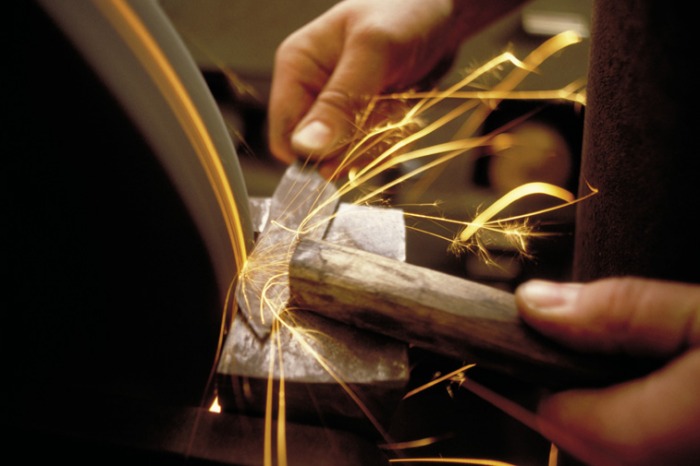South America, especially Argentina, is known for their unique, authentic, hand crafted Gaucho knives! There are several styles of Argentine knives, each style being made for a particular use and function. Depending on the knife style & intended use, a blade is crafted to compliment and complete every piece. Therefore it would be of interest to know the differences between carbon steel and stainless steel knife blades.
THE PROS AND CONS OF STAINLESS VS. HIGH CARBON STEEL KNIFE BLADES
When it comes to knife blades, there is a long list of metals that can be used. But generally speaking, there are two classifications in knife blades, stainless or high carbon steel knife blades. Each has their pros and cons and for the most part, you are just trading the shortcomings of one with the strength of the other. It all comes down to what you are using it for primarily. Some tasks are better suited for a carbon blade and the same goes for stainless blades.
STAINLESS STEEL
Stainless steel blades generally have at least 12% chromium which does two things for the blade. This makes the blade able to resist rust and corrosion a lot better than high carbon blades but the downside is stainless steel is generally softer than high carbon knives. This means stainless blades take a bit more effort in sharpening, they tend to lose their edge slightly quicker than harder, high carbon blades. Some of the most widely used stainless steel blades include 440’s (A, B and C), AUS 6, 8 and 10 and of course the Japanese made VG-10. Here are the advantages of stainless steel blades.
Durability. Stainless steel knife blades are generally tougher than high carbon blades. Tougher but not necessarily harder. There is an ongoing debate between the definitions of the two because, for the longest time, they have been considered synonyms. Stainless steel blades do not rust, chip or stain easily.
Flavor Preservation. Stainless steel knives do not require any protective or non-stick coating so there is less chance of contaminating your food if you do use it for food preparation. Stainless steel also will not leach off its metallic properties onto your food. Therefore, if the kitchen or BBQ is where you’ll be using your fixed blade knife, stainless steel is the absolutely best blade to use!
Appearance. Of course, the biggest pull of stainless steel knives is the fact that they look good for a very long time. Less time used in maintaining the knife gives you more time to do what it is you like to do.
HIGH CARBON STEEL
Carbon is the hardest element and knife blades made from high carbon steel are no exception. The strength and hardness of the blade makes it ideal for edge retention which means less time required for maintaining the blade. However, since carbon steel does not have a drop of chromium, it has a very poor rust resistance capability. This means that you need to thoroughly clean the knife after use and make sure that you guard it against moisture before you store it. More commonly used on fixed blade knives, high carbon knife blades are known to last throughout the years. I would bet my bottom dollar that you’re grand-daddy’s fixed blade knife blade is made from some kind of high carbon steel, most likely it is 1095m carbon steel. There are a lot of professional chefs and survivalist that swears to the quality of high carbon steel blades. To help you in your choice, here is a short list of the advantages of having a high carbon blade on your knife.
Sharpness. There is simply no matching the sharpness that high carbon steel blades can have. With skill and a lot of time, you can get a stainless steel knife sharp but not to the level of a high carbon steel blade. That added level of sharpness allows you better precision in cutting and requires a lot less effort. Thus, professional chefs prefer stainless steel blades but us a high carbon shaping steel for blade maintenance.
Affordable. Of course, the price of a knife generally depends on various factors, but high carbon steel knives tend to be a bit more affordable than their stainless steel counterparts. To clarify, cheaper in price but not in quality.
Hardness. High carbon steel blades are a lot harder than stainless steel which makes it a lot more dependable for precision cuts. Most blades for hunting knives are made from high carbon steel specifically because of this reason. One may argue that high carbon rust easier which makes it a terrible choice for an outdoors environment but that can be resolved by attention to your knife maintenance.
Edge Retention. Because they are harder, they also tend not to hold their edge as long as the stainless blades. This means sharpening your knife more often however, it sharpens to a extremely sharp edge which can cut through almost anything. A great example would be for a hunter skinning a deer out.
CONCLUSION
As with almost everything in the knife world, it all depends on what you prefer. It all depends on what you are willing to give and sacrifice for what you aim to gain. Stainless steel may be recyclable but high carbon blades will not burn a hole in your pocket. High carbon steel may be harder that stainless steel but stainless steel chip a lot less than high carbon. When it comes to looks, some prefer that clean shiny look of stainless while some appreciates the patina of a high carbon knife that shows that it has a lot of experience. As they say, to each his own.
MORE ABOUT GAUCHO KNIVES:
The Journey of a Gaucho Knife From Forge to Finish
The Significance of Gift-Giving Across Cultures
The Gaucho Knife: A Timeless Argentine Tradition
The Art of Gift-Giving: Exquisite Gaucho Knives for Special Occasions
What is a Falcón Knife?: A Look Into the Argentine Tradition

